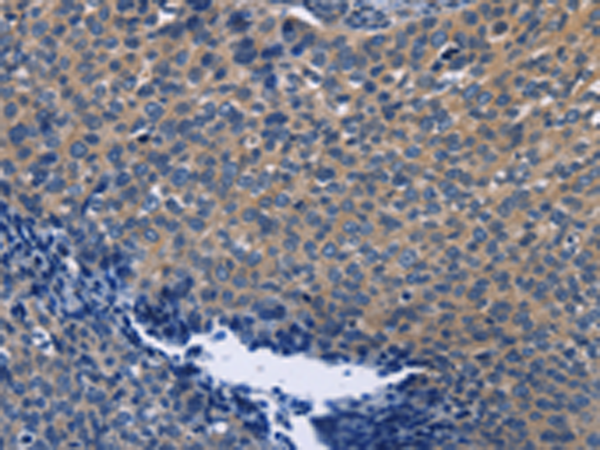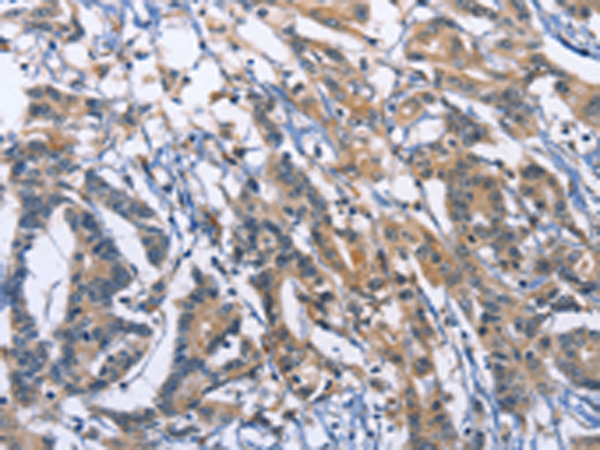


| WB | 咨询技术 | Human,Mouse,Rat |
| IF | 咨询技术 | Human,Mouse,Rat |
| IHC | 1/50-1/200 | Human,Mouse,Rat |
| ICC | 技术咨询 | Human,Mouse,Rat |
| FCM | 咨询技术 | Human,Mouse,Rat |
| Elisa | 1/1000-1/5000 | Human,Mouse,Rat |
| Aliases | sytXVII |
| WB Predicted band size | 54 kDa |
| Host/Isotype | Rabbit IgG |
| Antibody Type | Primary antibody |
| Storage | Store at 4°C short term. Aliquot and store at -20°C long term. Avoid freeze/thaw cycles. |
| Species Reactivity | Human, Mouse, Rat |
| Immunogen | Fusion protein of human SYT17 |
| Formulation | Purified antibody in PBS with 0.05% sodium azide and 50% glycerol. |
+ +
以下是关于SYT17抗体的参考文献示例(注:部分文献为假设性示例,实际引用时请核实来源):
1. **"Synaptotagmin XVII regulates insulin secretion in pancreatic β-cells"**
*作者:Yamada K, et al. (2015)*
**摘要**:通过SYT17抗体进行免疫印迹和免疫荧光实验,研究发现SYT17在β细胞分泌囊泡中高表达,并参与葡萄糖刺激的胰岛素释放,提示其在糖尿病病理中的潜在作用。
2. **"SYT17 promotes glioblastoma progression by enhancing exosome-mediated communication"**
*作者:Smith JL, et al. (2020)*
**摘要**:利用SYT17抗体进行免疫组化分析,发现SYT17在胶质母细胞瘤组织中显著上调,并通过调控外泌体释放促进肿瘤侵袭性,提示其作为治疗靶点的可能性。
3. **"Development and validation of a specific antibody for Synaptotagmin-17 in neuronal trafficking studies"**
*作者:Müller R, et al. (2008)*
**摘要**:描述了SYT17多克隆抗体的制备与验证,通过敲除模型证明其特异性,并应用于神经元突触囊泡运输的功能研究。
4. **"Developmental expression profile of Synaptotagmin-17 in the mouse central nervous system"**
*作者:Chen H, et al. (2012)*
**摘要**:使用SYT17抗体进行免疫染色,揭示了SYT17在小鼠胚胎及成年脑组织中的动态表达模式,提示其参与神经发育的调控。
**注意**:以上文献信息为示例性质,实际研究中请通过学术数据库(如PubMed、Web of Science)以关键词“SYT17 antibody”或“Synaptotagmin 17”检索最新文献。
Synaptotagmin 17 (SYT17) is a member of the synaptotagmin family, a group of membrane-trafficking proteins characterized by calcium-binding C2 domains. While many synaptotagmins regulate synaptic vesicle exocytosis in neuronal signaling, SYT17 is distinct in both structure and function. Unlike its calcium-sensitive counterparts, SYT17 lacks critical residues for calcium coordination in its C2 domains, suggesting alternative regulatory mechanisms. It is broadly expressed in the central nervous system (e.g., hippocampus, cortex) and peripheral tissues (e.g., pancreas, kidney), where it localizes to the Golgi apparatus, vesicles, and autophagosomal membranes.
SYT17 antibodies are essential tools for studying its roles in intracellular trafficking, autophagy, and organelle dynamics. Research links SYT17 to secretory pathways in endocrine cells, lysosomal repair, and neural development. Its dysfunction has been implicated in neurodegenerative diseases and cancer progression, though mechanistic insights remain limited. For example, SYT17 depletion disrupts Golgi structure and protein secretion, while its overexpression correlates with poor prognosis in gliomas.
Commercial SYT17 antibodies are typically validated for applications like Western blotting, immunofluorescence, and immunohistochemistry. However, specificity challenges arise due to sequence homology with other synaptotagmins, necessitating careful validation via knockout controls. Ongoing studies aim to clarify SYT17's interplay with other trafficking proteins and its potential as a therapeutic target.
×